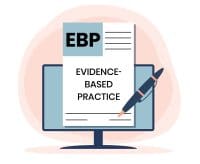When I speak to novice writers, one of the topics that frequently comes up is how to format references in the text and at the end of the article. Writers are sometimes confused because the different publications they read have different formats. Here’s what you need to know to avoid confusion.
The big two
Most journals use style guides to ensure consistency in many areas, with reference format the most relevant for this blog. The two main style guides used in nursing are the Publication Manual of the American Psychological Association (7th ed.) (APA), published by the American Psychological Association, and the AMA Manual of Style (11th ed.), produced by the American Medical Association.
APA vs. AMA
The APA and AMA style guides have different requirements, with one of the most important being how you cite a reference within the body of the text and in the reference list at the end of the article.
Writing clinical articles: A step-by-step guide for nurses
Follow the four Cs for effective writing
APA uses author and publication date citations within the text. The references are then listed in alphabetical order in the reference list.
Example
In-text citation: Four studies reported that the intervention was more effective than standard treatment (Smith et al., 2020; Rodriguez & Jones, 2021; Matsumoto, 2018; Brown, 2022). [Citations are fictitious.]
Reference list example: Butcher, B. W., Eaton, T. L., Montgomery-Yates, A. A.; & Sevin C. M. (2022). Meeting the challenges of establishing intensive care unit follow-up clinics. American Journal of Critical Care, 31(4), 324-328. https://doi.org/10.4037/ajcc2022987
AMA uses superscripted numbers that are consecutively numbered within the body of the text. All the references are then listed in numerical order in the reference list.
Example
In-text citation: Four studies reported that the intervention was more effective than standard treatment.1-4
Reference list example: 1. Butcher BW, Eaton TL, Montgomery-Yates AA, Sevin CM. Meeting the challenges of establishing intensive care unit follow-up clinics. Am J Crit Care. 2022;31(4):324-328. doi:10.4037/ajcc2022987
The examples above illustrate journal articles. The format varies for other types of references such as books and websites. Note that the AMA citation style is more streamlined than APA.
One tip: You may not be familiar with DOI, which stands for digital object identifier. A DOI link takes you to a permanent location of an article online; it was established as a way to ensure articles are easy to retrieve online after they have been published. Most (but not all) articles published after 2010 will have a DOI. If it’s not listed at the start or end of the article, you can try looking up the article for free at PubMed (https://www.ncbi.nlm.nih.gov/pubmed/citmatch) or Crossref (https://www.crossref.org/guestquery). Keep in mind, however, that not all journals are indexed in these databases.
How to choose
So should you follow the APA or AMA style guide? To make that decision, turn to the author guidelines (also called instructions for authors), which should tell you what style the journal prefers. You can find author guidelines on the publication’s website. You also can check past issues.
When reviewing the author guidelines, pay attention to specific instructions regarding reference formatting. For example, ANJ uses the AMA style guide with some modifications—we don’t use superscripts in text and we alphabetize the reference list.
Use the most recent edition of the style guide to ensure you’re using the most current reference format. Getting it right the first time will ensure you don’t have to reformat the references later.
References
American Psychological Association. Publication Manual of the American Psychological Association. 7th ed. Washington, DC: American Psychological Association; 2020.
JAMA Network Editors. AMA Manual of Style: A Guide for Authors and Editors. 11th ed. Oxford, UK: Oxford University Press; 2020.
Nicoll LH. Finding and documenting sources. In: Saver C. Anatomy of Writing for Publication for Nurses. 4th ed. Indianapolis, IN: Sigma Theta Tau International; 2021; 81-91.


Whether you’re considering your first or your 50th publication, want to contribute to your organization’s newsletter, or crave to be a better communicator online and in print, I hope you’ll find what I write helpful. The nurse publishing colleagues I’ve learned from over the years (many of whom are contributors to my book) may not be listed by name, but I’m grateful for their willingness to share. In that spirit, I’m looking forward to sharing with you! If you have feedback, feel free to email me at csaver@healthcommedia.com.




















2 Comments. Leave new
Thank you so much for sharing this information.
Great site about the reference formats.